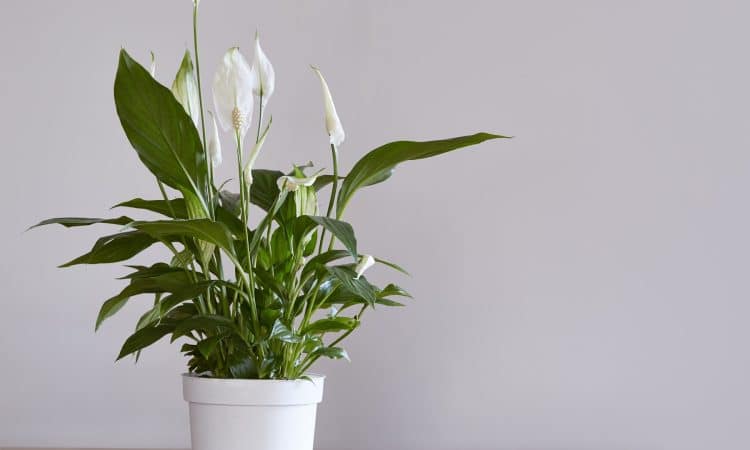
If you’re looking for a beautiful plant to add to your home, you can’t go wrong with a spathiphyllum, or peace lily. They’re known for their gorgeous green foliage and white flowers.
These flowers have become the symbol of peace, hence the name. They do best on the soil of the South American rainforest, where they receive constant raindrops of rainwater and diffused light.
However, peace lilies are toxic to pets and children, so it’s best to keep them out of the curiosity of the young and furry.
Peace lilies – how to care for them
Peace lilies can cope with dry soil, so don’t worry if you forget to water them from time to time. A novel method of watering flowers is to use ice cubes. But beware, this method is not suitable for all types of plants.
It will survive in most light conditions, but a good amount of indirect light will ensure that the plant continues to produce those beautiful flowers.
They love moisture, so spray them with water every few days or keep them in a damp room such as the kitchen or bathroom. Alternatively, place them next to other plants. As a group, they’ll create their own microclimate.
Water the plant infrequently with purified water when the top couple inches of soil are dry. Tap water can be harmful to peace lilies, so it’s better to use rainwater. Try leaving a container outside the window to collect rainwater for it.
East-facing windows are perfect for peace lilies as they provide moderate light without burning the leaves. Find it a spot in indirect light, away from the sun’s scorching rays, so it’ll always make beautiful blooms.
Wild peace lilies thrive in the rainforest, so your houseplant will be comfortable in temperatures around 16-21°C. Keep it away from heat sources and cold draughts or it may wilt.
Repot the peace lily in spring if the roots start to emerge through holes in the base of the plastic pot. Choose another plastic pot 1-2 sizes larger (about 2-5 cm) to give it room to grow.
Peace lilies can be divided into several plants by dividing the clump, making sure each new plant has strong roots to grow.
The plant may need time to adjust to its new home, so don’t panic if it stops flowering for a while.
You don’t need to worry too much about fertilizing your peace lily. Add a liquid fertilizer to the water occasionally throughout the spring and summer. This should give it enough nutrients to give it a little boost.
Wiping off the leaves is all it needs to stay shiny. Keep it healthy and dust-free by using a damp cloth to clean its leaves or give it a light spray to keep it shiny.
Where to place peace lily in your home
In its natural tropical habitat, this plant would enjoy steamy conditions due to its rainforest environment.
So make the lily feel at home by placing it in an area with high humidity, such as your kitchen or bathroom. If your chosen spot isn’t as humid as you’d like, spray the leaves regularly, especially in the summer months or, if you like the idea of a group of plants in your home, place them close together and amazingly they will act as humidifiers for each other.
To keep the peace lily thriving and to encourage those beautiful white flowers to bloom, keep it away from draughts and radiators.
Unfortunately, the peace lily is not a pet-friendly plant, so if you have furry friends, keep the plant in a place inaccessible to them.
Common Spathiphyllum problems
Why peace lily doesn’t bloom again
If your plant isn’t flowering, try moving it to a brighter spot in the house so that it gets a little more light, but avoid direct sunlight as this will burn the leaves. You can also try using a little plant fertilizer.
Why the leaves are yellow
The most likely reason your lily’s leaves are yellow is overwatering. It’s best to move the plant to a shady spot, check that the water is draining properly and stop watering until the soil has dried out. To check if your plant needs water, stick your finger about an inch into the soil around the plant. If the soil is dry, water the plant.
Although less common, another possible reason your lily’s leaves are yellow is a lack of nutrients. You can usually tell if this is the reason by looking at the plant’s veins; if they are still green, then the yellow leaves are probably caused by a lack of nutrients.
To remedy this, you should increase the frequency of fertilizer use to once a month until the problem is solved. Don’t be too generous with fertilizer as too much can cause problems.
Why the plant bends
Peace lilies are excellent communicators, and the drooping leaves are their way of letting us know they are thirsty. The moment you notice the leaves drooping, give them a little water and this should revive your beautiful plant in about an hour.
When you should repot the lily
When your plant has outgrown its pot, it can be repotted into a larger one in early spring. Make sure you use good quality potting soil and a well-drained pot.
Favorable weather conditions during these seasons allow the plant to awaken from dormancy, bear buds and flowers, and thrive.
Repotting a peace lily can accelerate its growth. And the ideal time for this task is spring, although late winter or early summer works just as well.
To minimize replanting shock, it’s best to transfer the plant in spring. However, urgent repotting doesn’t have to be postponed, and you can do it at any time of the year. But make sure that the roots experience minimal disturbance. It’s also important to use the right soil mix and pot of the right size.

